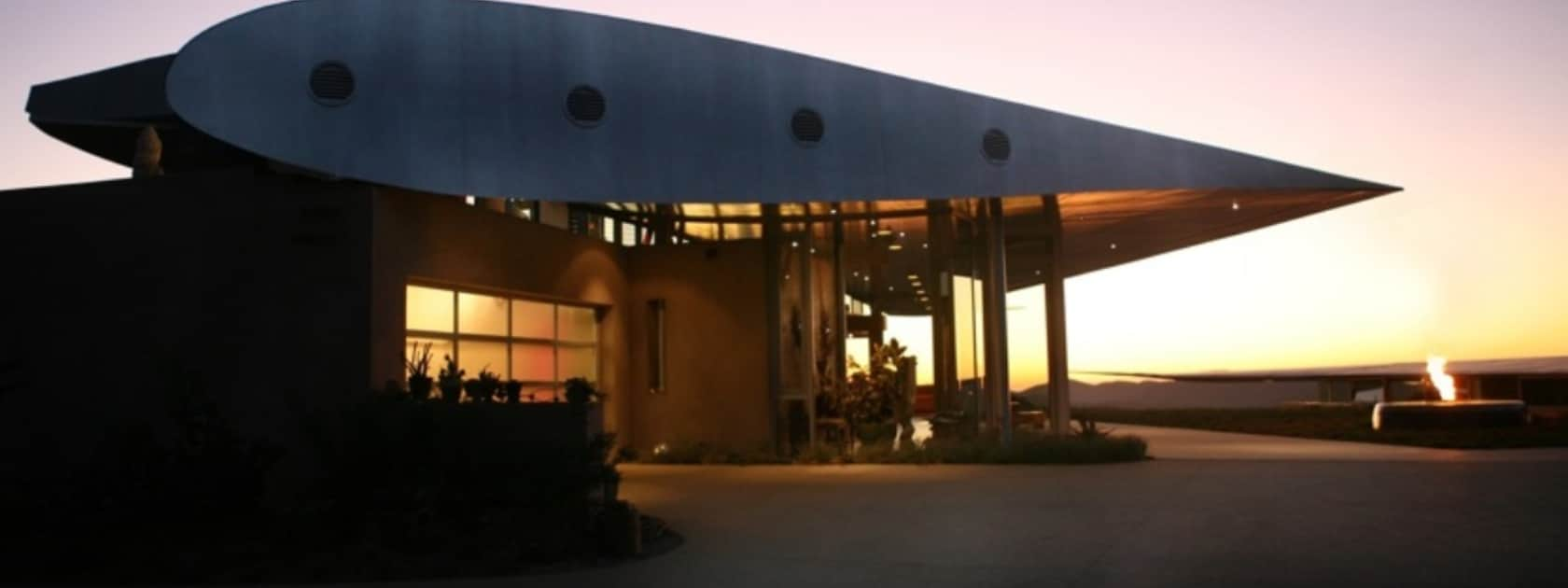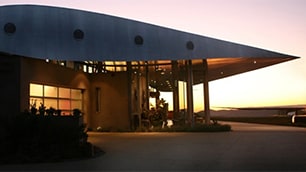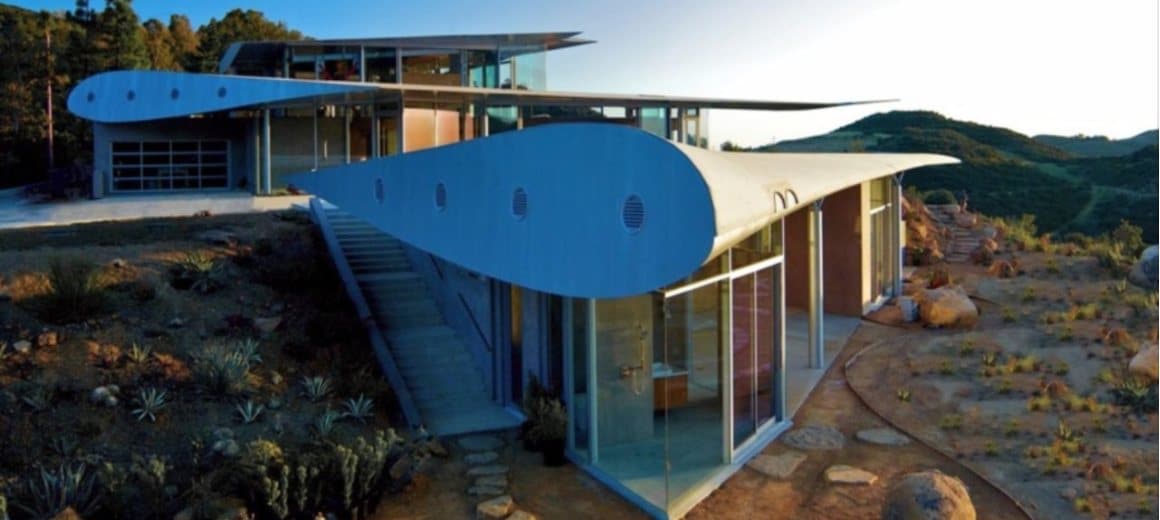A look at the 747 Wing House by architect David Hertz
If you’ve never heard of the 747 Wing House, then you’re in for a treat. When it comes to air travel, whether by commercial airliner or private jet charter, most travelers are usually happy to just keep a memento to remember their trip. But this luxury house in Malibu, California, has a roof that gives a permanent nod to aviation – and Boeing. Let’s take a look at the story of this fascinating project and David Hertz’s architectural ingenuity.
Vision of a wing-roofed home
The idea for the famous Malibu airplane house began with a request from owner Francie Rehwald for a modern home with soft, feminine lines. US architect David Hertz was determined to find a building solution that in no way interfered with the property’s sweeping views of mountains, valleys, and the ocean. He visualized a floating, self-supporting roof that seemed to hover over the site and meld with the curves and sweep of the landscape. Hertz’s first concept sketches showed a curved ceiling and a roof form that reminded him of the wing section of an airplane.
Hertz began researching airplane wings and superimposing different wing types on the site to scale. The 2,500sq ft wing of a Boeing 747-100 jumbo jet seemed to fit most beautifully. He showed Rehwald a series of photographs he’d taken of the sculptural, feminine, curvilinear shapes of the airplane’s wings and fuselage sections. She embraced his vision and they arranged to view the enormous, sinuous curves of an airplane up close before agreeing to go ahead.
A jetliner’s boneyard reprieve
The plane that was destined to be converted into luxury property was sourced from one of California’s many airplane ‘boneyards’, where retired aircraft wait in the desert to be sold or scrapped for raw material.
Interestingly, the Wing House was to be built on the former home of artist and Hollywood set designer Tony Duquette and his wife, who were also upcyclers and had created more than 20 structures from recycled objects and film sets. The Duquettes sold the property after it burned down in the Green Meadow wildfire of 1993.
The Boeing 747-100 airplane was purchased for Hertz’s project for $30,000 (its original price in 1970 was $25 million) before being detoxified and cut apart using a laser and cut-off saws at the Victorville Airport in San Bernardino County. First, the cockpit and tail were removed, and the fuselage cut longitudinally. Then transverse sectioning reduced large segments of the fuselage and wings to a manageable size, ready for transport.
Journey of the old airplane to the building site
Three major freeways were closed overnight so that a truck accompanied by seven California Highway Patrol vehicles could transport the plane parts to Camarillo Airport in Oxnard, Ventura County. With each wing weighing 20,000lbs, the only way to transport them to the remote building site in Santa Monica was by cutting them in two and flying them by helicopter – a Columbia Model 234 Commercial Chinook – to set them down on a large pile of tires. The wings were then spliced back together and hoisted onto columnar supports to form the beginnings of the floating roof. They were secured in place by connecting custom fabricated steel brackets on the columns to the engine mounts on the wings.
The 747 Wing House takes shape
Hertz had to make sure the construction project kept progressing through obstructions and red tape – 17 government agencies had to give their approval. One point he was careful to check with aviation experts and aerospace consultants was that no ‘uplift’ would be created by the wings once they were finally in place! The roof of the house also had to be registered with the Federal Aviation Administration (FAA) so pilots flying overhead – whether private jets or commercial airliners – wouldn’t mistake the house for a downed aircraft.
Contrary to what you might expect from the house’s name, the team was able to use every part of the airplane fuselage, along with the wings and tail section. The main house is made up of two buildings linked on three levels, using two wings and two horizontal stabilizers from the Boeing 747-100. The ceilings on the lower part of the house are 18ft tall and topped with the plane’s left wing. The upper structure of the main house uses the right wing as the roof, with two horizontal stabilizers above the master bedroom and bathroom.
Ultimately, it’s not the glossy, majestic sweep of the airplane wings alone that make this building work so well. The genius is in the way they’ve been cleverly positioned to float atop simple concrete walls cut into the hillside and frameless, self-supporting glass windows and doors. The 747’s fuselage covers a stunning guesthouse, barn, and an art studio, each housed in a separate building. There’s also a meditation pavilion located at the edge of the site, which was made from the plane's cockpit. This magnificent plane-to-eye-catching-home conversion project was completed in October 2011.
Cost of the plane-to-house conversion
While the total cost of the project hasn’t been disclosed, Hertz says that for almost $30,000, the building gained an enormous amount of material from an aircraft over 230ft long, 195ft wide, and 63ft tall, with 17,000 cubic feet of cargo space. Pre-fabricating lightweight components offsite saved a substantial amount of carbon dioxide output and construction waste. Having these components delivered to the building site via helicopter resulted in considerable cost-saving, even at almost $8,000 an hour, compared to the cost of getting traditional labor and material up and down the remote hills of Santa Monica.
More extraordinary homes around the world
The 747 Wing House isn’t the world’s only extraordinary house. Here are some more unusual homes worth knowing about:
The airplane house in Miziara, Lebanon
This eccentric home is situated in Zgharta District in the North Governorate of Lebanon, in the village of Miziara, which is known for its luxurious villas and affluent mansions. Surprisingly, ‘Airplane House’ was not built from any airplane material, but rather, designed and made to resemble an Airbus A380. Michael Suleiman always dreamed of turning his fascination with airplanes into a house – and when he grew up, he made it a reality by building the airplane house.
The Pole House in Victoria, Australia
If you’ve booked a private plane rental for Victoria, Australia, consider staying at the most photographed house on the Great Ocean Road. The Pole House is suspended on a horizontal pole 40 meters above Fairhaven Beach, and it’s one of Australia’s most iconic homes. The sound of crashing waves delights guests, who can take in 360-degree views above one of the most spectacular coastlines in the country.
Casa del Acantilado in Granada, Spain
GilBartolomé Architects built this amazing psychedelic house in Granada, Spain, which is ingeniously merged into a cliff face. It is perched high above the Mediterranean Sea and features an unusual, organic form with a scale-like outer appearance. Casa del Acantilado (‘house on the cliff’) was built to handle the local climate: its shell was designed to keep the interiors cool in the summer months by systematically regulating the flow of air. The structure sits at a 42-degree incline and has stunning coastal views.
Book a private charter at ACS
If you’d like to travel the world in search of more extraordinary homes, why not book a private jet charter with Air Charter Service (ACS)? At ACS, we provide private jet prices for business and leisure, as well as group charter options that can be tailored to your requirements. To find out all you need to know about chartering a private plane, contact our team, who’ll take you through the broad choice of aircraft you could fly on, and provide you with the relevant private plane costs and anything else you need to know.

 Ever wondered what happens to retired aircraft? A wing-roofed house probably wouldn’t be your first guess. Let’s take a look at the 747 Wing House in California, designed by architect David Hertz, as well as some other extraordinary homes around the world.
Ever wondered what happens to retired aircraft? A wing-roofed house probably wouldn’t be your first guess. Let’s take a look at the 747 Wing House in California, designed by architect David Hertz, as well as some other extraordinary homes around the world.



